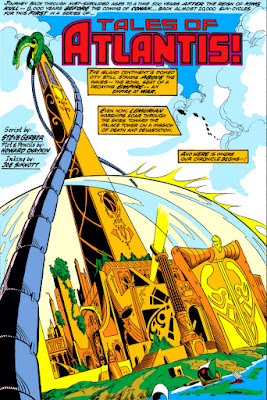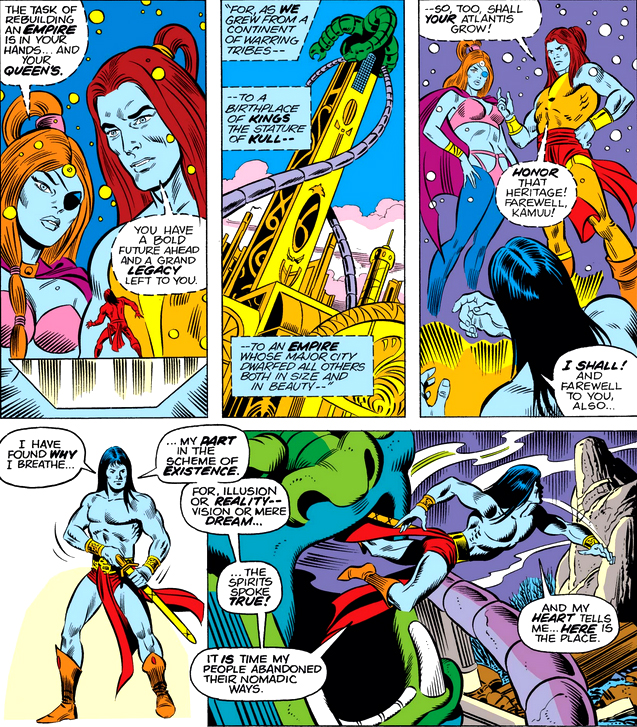As the original Sub-Mariner series closed in on its final issue, writer Steve Gerber began including within the book a five-part origin tale for Atlantis itself which would not only establish the roots of the rise of Namor's own kingdom but also be a strong contender* for how the legendary surface continent of Atlantis met its end. Taking place in 1973 from June-October, the story also offers fine artwork by Howard Chaykin (who was also this project's plotter) and Joe Sinnott, though Chaykin is replaced by Jim Mooney in the last two installments. Regrettably, Tales Of Atlantis, limited to only six pages per issue, would only be able to offer a digest version of what might have been possible in a dedicated series--covering all the important aspects but with little opportunity for meaningful character development, in addition to the blink-and-you-missed-it existence of Atlantis itself, which we learn more of through Gerber's narrative than from its dwellers.
*A collection of the various mentions in Marvel stories regarding the fate of Atlantis probably rates a post of its own, but the PPC has referenced one such version, which gives a much different account of the city's destruction than Gerber's effort. As for the history of Namor's Atlantis, the story is given more in-depth treatment (heh, get it?) in a separate post in terms of the devastation it suffered during the reign of Thakorr and, later, Namor.
For instance, we're told that the ancient city of Atlantis is located on an "island continent," which one might consider to be a contradiction in terms given the size differential between a continent and an island. In the writings of Plato around 360 B.C.--the only known records of its existence--the Atlantis we know was made up of several concentric islands separated by wide moats and linked by a canal that ran to a central island where sat the capital city. In Gerber's story, Atlantis the city was the ruling seat of an empire, which implies that Atlantis the empire was more like Rome in that its reach extended to broad expanses of other lands. Otherwise, you could liken it to, say, Australia, with the jury still out as far as that country being an island or a continent but usually referred to as the latter since it has its own tectonic plate (though it extends to other islands such as Tasmania).
At any rate, the takeaway is that in this story the original Atlantis was an ancient surface empire, which we come across in its last days as a world power and the city itself besieged by two foreign armies--one of which, the Lemurians (also apparently air-breathers, like the Atlanteans), is intent on destroying the city's protective dome in order to allow its forces and a naval assault by another kingdom to breach the city itself. The waters here are muddied a bit by the Atlanteans being portrayed as blue-skinned, which Marvel later clarified was attributed to a colorist error (Petra Goldberg is the credited colorist in the issue) which wasn't discovered until the proofs of the first Tales Of Atlantis story were seen (which also clears up the discrepancy of Kull being flesh-colored, despite being born in Atlantis). At the behest of Asst. Editor Marv Wolfman, the blue coloring was retained in further installments for consistency's sake.
Atlantis is ruled by Kamuu and the Lemurian-born Zartra, who like any warriors at the time are defiant to the end. Yet a fatal miscalculation meant to destroy the invaders at a stroke seals their own doom.
Up until now, the legend of the existence of Atlantis passed down from the time of Plato has centered on a great cataclysm of unknown origin which sent an incredible city of its time to the bottom of the ocean.** Here, Gerber creates fairly believable elements more rooted in man's warlike nature, aided by the connotation of "empire" as one country expanding its influence and authority over other nations whether welcomed or not. By all appearances, Kamuu and Zartra are proud warrior-rulers of a warrior race whose power had finally ebbed to the point where they were vulnerable to usurpers. Their enemy's fate which they themselves ultimately suffered, of their own doing, must have seemed fitting to those who were surely celebrating in their wake.
**Charles Orser, curator of history at the New York State Museum in Albany, describes the legend as a story about a moral, spiritual people who created a highly advanced, utopian civilization but became greedy, petty, and "morally bankrupt," and the gods "became angry because the people had lost their way and turned to immoral pursuits." As punishment, the gods sent "one terrible night of fire and earthquakes" that caused Atlantis to sink.
In the end, Kamuu and Zartra resign themselves to their swiftly approaching end, sealing themselves off from those whom they've advised to do the same--but because of a Lemurian lying in wait, Kamuu will find death taking its toll on him personally, even in isolation with his queen.
From here, we cut to 5,000 years later, where two warring, nomadic tribes of sea-breathing warriors from the world's two major oceans meet in battle to claim the ruins (and treasures) of the surface-men of Atlantis. King Stegor, of the Atlantic forces, slays King Tanas, who is then avenged by his wife, Queen Elanna. Afterward, Elanna vows to found a city-nation on the ruins.
Unfortunately, Elanna's bold words only anger Stegor's brother, Orrek, who has no intention of abandoning the ruins in defeat--mostly because, with Stegor's death, he schemes to claim his brother's throne for himself. Yet to do so, he must arrange for his nephew to be killed--a boy who appears to have been named for a man who once ruled the legendary city that has been in contention.
Kamuu's "scouting mission" takes him into the ruins, where he finds and makes use of the original Kamuu's sword to battle a skeletal guardian of an Atlantean temple who has pursued him into what had been the royal palace. Upon seeing Kamuu wield the sword, the guardian attacker halts and surrenders immediately--at which point Kamuu succumbs to a vision in which appears his namesake as well as Zartra, who pass their legacy on to the boy and whomever he may choose as his future queen.
Judging by his words, the original Kamuu appears to have a biased view of what regard his own empire was held in by those other nations under its control, conveniently leaving out any details of the circumstances of his empire's demise--nor does our young Kamuu stop to consider that this legacy ultimately ended in ruin at the bottom of the ocean.
Still, Kamuu has taken the words to heart, and his aspirations are noble--and there is one who joins him who, through a bold gesture of her own, seeks to appeal to those intentions and begin that work under the banner of peace.
Though Marvel would later report that there was overwhelming desire to see Tales Of Atlantis continue, further installments of the story would remain in limbo due to Sub-Mariner having been shifted to bi-monthly publication and "no room elsewhere to put the series." Despite further cajoling from Marvel to readers to write in support of continuing TOA, the point would soon become moot with the abrupt cancellation of Sub-Mariner six issues later.
Without intending it as such, you might find interesting an informal follow-up to the final revelations of Tales Of Atlantis in a prior post which takes a look at how Atlantis fared in fulfilling the glorious prophecy of Kamuu and Zartra (not to mention that of Neptune)--proof that even prophets and gods can misread destiny now and then.















6 comments:
There's a theory that legends of drowned cities like Atlantis come from ancient folk memories of huge floods caused by melting glaciers at the end of the last ice age.
Atlantis has also been blamed for the disappearance of ships and planes in the Bermuda Triangle. One theory claims that an ancient, powerful Atlantean machine is still operating and is dragging ships and planes down to a watery doom!
I don't know, Colin--if we're going down that road, maybe our theoretician should be focused instead on the possibility that the Bermuda Triangle might be responsible for the sinking of Atlantis! :)
I've read this statistical observation: if you take the area called "the Bermuda Triangle" and place that same area on any other patch of ocean, the Triangle actually has fewer incidents of shipwrecks and misfortune than anywhere else. So, if there is an ancient Atlantean machine, it's apparently doing its creaky, decaying best to prevent maritime disaster.
Blue-skins might be called a colourist error, but Atlantean troops in the modern day are always blue-skinned following their half-breed Prince Namor. Attuma is blue-skinned. It's a pretty easy "error" to make when given this assignment for the back up story in a Submariner comic book.
Atlantis and underwater mapping in the Marvel Universe always bugged me for being so vague and contradictory. No matter where in all the wide seven seas of the planet Earth a surface hero goes underwater, they meet Namor, often with Atlantean troops to hand.
Call me pedantic, but I can't help wondering why that fellow is wearing non-matching boots.
B, if you're referring to Kamuu, excellent observation. :) (But I think only Zartra would call it to his attention--even so, she might want to have her sword at the ready!)
Post a Comment